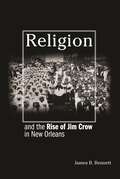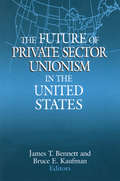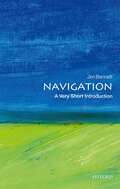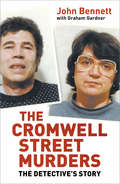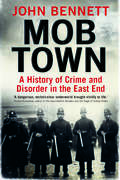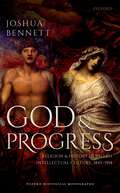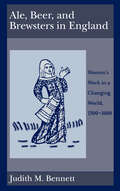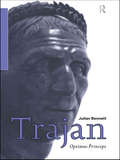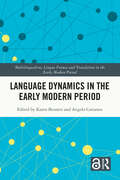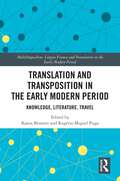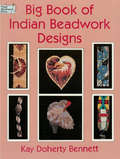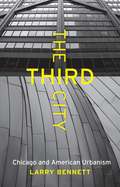- Table View
- List View
Religion and the Rise of Jim Crow in New Orleans
by James B. BennettReligion and the Rise of Jim Crow in New Orleans examines a difficult chapter in American religious history: the story of race prejudice in American Christianity. Focusing on the largest city in the late-nineteenth-century South, it explores the relationship between churches--black and white, Protestant and Catholic--and the emergence of the Jim Crow laws, statutes that created a racial caste system in the American South. The book fills a gap in the scholarship on religion and race in the crucial decades between the end of Reconstruction and the eve of the Civil Rights movement. Drawing on a range of local and personal accounts from the post-Reconstruction period, newspapers, and church records, Bennett's analysis challenges the assumption that churches fell into fixed patterns of segregation without a fight. In sacred no less than secular spheres, establishing Jim Crow constituted a long, slow, and complicated journey that extended well into the twentieth century. Churches remained a source of hope and a means of resistance against segregation, rather than a retreat from racial oppression. Especially in the decade after Reconstruction, churches offered the possibility of creating a common identity that privileged religious over racial status, a pattern that black church members hoped would transfer to a national American identity transcending racial differences. Religion thus becomes a lens to reconsider patterns for racial interaction throughout Southern society. By tracing the contours of that hopeful yet ultimately tragic journey, this book reveals the complex and mutually influential relationship between church and society in the American South, placing churches at the center of the nation's racial struggles.
Not Invited to the Party: How the Demopublicans Have Rigged the System and Left Independents Out in the Cold
by James T. BennettNot Invited to the Party demonstrates how the dominant political parties--the Democrats and Republicans--have co-opted the system to their advantage. James Bennett examines the history and array of laws, regulations, subsidies and programs that benefit the two major parties and discourage even the possibility of a serious challenge to the Democrat-Republican duopoly. The American Founders, as it has been generally forgotten, distrusted political parties. Nowhere in the U.S. Constitution are parties mentioned, much less given legal protection or privilege. This provocative book traces how by the end of the Civil War the Republicans and Democrats had guaranteed their dominance and subsequently influenced a range of policies developed to protect the duopoly. For example, Bennett examines how the Federal Election Campaign Act of 1971 (as amended in 1974 and 1976), which was sold to the public as a nonpartisan act of good government reformism actually reinforced the dominance of the two parties. While focused primarily on the American experience, the book also considers the prevalence of two-party systems around the world (especially in emerging democracies) and the widespread contempt with which they are often viewed. Featuring incisive commentary on the 2008 election, and a foreword by third-party iconoclast, Ralph Nader, the book considers the potential of truly radical reform toward opening the field to vigorous, lively, contentious independent candidacies that might finally offer alienated voters a choice, not an echo.
Stifling Political Competition: How Government Has Rigged the System to Benefit Demopublicans and Exclude Third Parties (Studies in Public Choice #12)
by James T. BennettStifling Political Competition examines the history and array of laws, regulations, subsidies and programs that benefit the two major parties and discourage even the possibility of a serious challenge to the Democrat-Republican duopoly. The analysis synthesizes political science, economics and American history to demonstrate how the two-party system is the artificial creation of a network of laws, restrictions and subsidies that favor the Democrats and Republicans and cripple potential challenges. The American Founders, as it has been generally forgotten, distrusted political parties. Nowhere in the U.S. Constitution are parties mentioned, much less given legal protection or privilege. This provocative book traces how by the end of the Civil War the Republicans and Democrats had guaranteed their dominance and subsequently influenced a range of policies developed to protect the duopoly. For example, Bennett examines how the Federal Election Campaign Act of 1971 (as amended in 1974 and 1976), which was sold to the public as a nonpartisan act of good government reformism actually reinforced the dominance of the two parties. While focused primarily on the American experience, the book does consider the prevalence of two-party systems around the world (especially in emerging democracies) and the widespread contempt with which they are often viewed. The concluding chapter considers the potential of truly radical reform toward opening the field to vigorous, lively, contentious third-party candidacies that might finally offer alienated voters a choice, not an echo.
The Future of Private Sector Unionism in the United States
by James T. Bennett Bruce E. KaufmanA study of the long-term decline of the labour movement in America, exploring the outlook for labour and unions in the 21st century. There are insights from contributors from a range of backgrounds - academic and non-academic, domestic and foreign, pro- and anti-union.
The Future of Private Sector Unionism in the United States (Issues In Work And Human Resources Ser.)
by James T. Bennett Bruce E. KaufmanA study of the long-term decline of the labour movement in America, exploring the outlook for labour and unions in the 21st century. There are insights from contributors from a range of backgrounds - academic and non-academic, domestic and foreign, pro- and anti-union.
A History of Pew Renting in the Church of England
by J.C. BennettThis book is a comprehensive study of the history of pew-renting in the church of England, from the first known rented sittings in the fifteenth century to the system’s collapse in the twentieth. The book’s significance is partly its originality; no book and very few articles or portions of books have appeared solely on pew-renting since the nineteenth century, and even those of that time were not histories – they were polemical works that generally attacked pew-renting on religious grounds. This work encompasses the distinction between formal letting of seats – which involved the methodical letting of sittings by church authorities with set rents – and informal pew-letting, in which congregants tipped pew-openers and sidesmen for favourable seats for one service. It also details the concomitant difficulties and hindrances encountered by churches and renters, the means of setting the rents and collecting the proceeds, the types of congregants who rented pews, thecontroversy the practice provoked, and the deception and bending – and sometimes outright breaking – of the applicable law.
Navigation: A Very Short Introduction (Very Short Introductions)
by Jim BennettFrom the Bronze Age mariners of the Mediterranean to contemporary sailors using satellite-based technologies, the history of navigation at sea, the art of finding a position and setting a course, is fascinating. The scientific and technological developments that have enabled accurate measurements of position were central to exploration, trade, and the opening up of new continents, and the resulting journeys taken under their influence have had a profound influence on world history. In this Very Short Introduction Jim Bennett looks at the history of navigation, starting with the distinctive cultures of navigation that are defined geographically - the Mediterranean Sea, and the Pacific, Indian, and Atlantic Oceans. He shows how the adoption of mathematical methods, the use of instruments, the writing of textbooks and the publication of charts all combined to create a more standardised practice. Methods such as longitude-finding by chronometer and lunar distance were complemented by the routine business of recording courses and reckoning position 'by account'. Bennett also introduces the incredible array of instruments relied on by sailors, from astrolabes, sextants, and chronometers, to our more modern radio receivers, electronic equipment, and charts, and highlights the crucial role played by the individual qualities of endeavour and resourcefulness from mathematicians, scientists, and seamen in finding their way at sea. The story of navigation combines the societal, the technical, and the human, and it was vital for shaping the modern world. ABOUT THE SERIES: The Very Short Introductions series from Oxford University Press contains hundreds of titles in almost every subject area. These pocket-sized books are the perfect way to get ahead in a new subject quickly. Our expert authors combine facts, analysis, perspective, new ideas, and enthusiasm to make interesting and challenging topics highly readable.
Navigation: A Very Short Introduction (Very Short Introductions)
by Jim BennettFrom the Bronze Age mariners of the Mediterranean to contemporary sailors using satellite-based technologies, the history of navigation at sea, the art of finding a position and setting a course, is fascinating. The scientific and technological developments that have enabled accurate measurements of position were central to exploration, trade, and the opening up of new continents, and the resulting journeys taken under their influence have had a profound influence on world history. In this Very Short Introduction Jim Bennett looks at the history of navigation, starting with the distinctive cultures of navigation that are defined geographically - the Mediterranean Sea, and the Pacific, Indian, and Atlantic Oceans. He shows how the adoption of mathematical methods, the use of instruments, the writing of textbooks and the publication of charts all combined to create a more standardised practice. Methods such as longitude-finding by chronometer and lunar distance were complemented by the routine business of recording courses and reckoning position 'by account'. Bennett also introduces the incredible array of instruments relied on by sailors, from astrolabes, sextants, and chronometers, to our more modern radio receivers, electronic equipment, and charts, and highlights the crucial role played by the individual qualities of endeavour and resourcefulness from mathematicians, scientists, and seamen in finding their way at sea. The story of navigation combines the societal, the technical, and the human, and it was vital for shaping the modern world. ABOUT THE SERIES: The Very Short Introductions series from Oxford University Press contains hundreds of titles in almost every subject area. These pocket-sized books are the perfect way to get ahead in a new subject quickly. Our expert authors combine facts, analysis, perspective, new ideas, and enthusiasm to make interesting and challenging topics highly readable.
The Cromwell Street Murders: The Detective's Story (Sutton Ser.)
by John BennettNovember 2005 marks the tenth anniversary of the conviction of Rose West, currently serving ten life sentences for her part in the Cromwell Street murders. This book tells for the first time the story from a police perspective. For ten years, the officer in charge of the investigation, Detective Superintendent John Bennett QPM, has refused to tell his story. Now, together with BBC journalist Graham Gardner, he reveals the full story of how the West's were caught, how the case was prepared and how it nearly failed to come to court. This book chronicles the roles of those who brought down two of Britain's most infamous killers, shedding light on the real heroes of one of the saddest chapters of criminal history. It explores the court processes, the complications of Rose West's trial, her unsuccessful appeal and the difficulty of dealing with witnesses in such a traumatic case. On one level, this is a story of the triumph of good over evil; on another it is a detailed documentation of how a murder investigation really works - the pressures, the commitment and the physical and emotional drain on those who carry out this work.
Mob Town: A History of Crime and Disorder in the East End
by John BennettA captivating history of a notorious neighborhood and the first book to reveal why London’s East End became synonymous with lawlessness and crime Even before Jack the Ripper haunted its streets for prey, London’s East End had earned a reputation for immorality, filth, and vice. John Bennett, a writer and tour guide who has walked and researched the area for more than thirty years, delves into four centuries of history to chronicle the crimes, their perpetrators, and the circumstances that made the East End an ideal breeding ground for illegal activity. In the eighteenth and nineteenth centuries, Britain’s industrial boom drew thousands of workers to the area, leading to overcrowding and squalor. But crime in the area flourished long past the Victorian period. Drawing on original archival history and featuring a fascinating cast of characters including the infamous Ripper, highwayman Dick Turpin, the Kray brothers, and a host of ordinary evildoers, this gripping and deliciously unsavory volume will fascinate Londonphiles and true crime lovers alike.
God and Progress: Religion and History in British Intellectual Culture, 1845 - 1914 (Oxford Historical Monographs)
by Joshua BennettExploring the rich relationship between historical thought and religious debate in Victorian culture, God and Progress offers a unique and authoritative account of intellectual change in nineteenth-century Britain. The volume recovers a twofold process in which the growth of progressive ideas of history transformed British Protestant traditions, as religious debate, in turn, profoundly shaped Victorian ideas of history. It adopts a remarkably wide contextual perspective, embracing believers and unbelievers, Anglicans and nonconformists, and writers from different parts of the British Isles, fully situating British debates in relation to their European and especially German Idealist surroundings. The Victorian intellectual mainstream came to terms with religious diversity, changing ethical sensibilities, and new kinds of knowledge by encouraging providential, spiritualized, and developmental understandings of human time. A secular counter-culture simultaneously disturbed this complex consensus, grounding progress in appeals to scientific advances and the retreat of metaphysics. God and Progress thus explores the ways in which divisions within British liberalism were fundamentally related to differences over the past, present, and future of religion. It also demonstrates that religious debate powered the process by which historicism acquired cultural authority in Victorian national life, and later began to lose it. The study reconstructs the ways in which theological dynamics, often relegated to the margins of nineteenth-century British intellectual history, effectively forged its leading patterns.
God and Progress: Religion and History in British Intellectual Culture, 1845 - 1914 (Oxford Historical Monographs)
by Joshua BennettExploring the rich relationship between historical thought and religious debate in Victorian culture, God and Progress offers a unique and authoritative account of intellectual change in nineteenth-century Britain. The volume recovers a twofold process in which the growth of progressive ideas of history transformed British Protestant traditions, as religious debate, in turn, profoundly shaped Victorian ideas of history. It adopts a remarkably wide contextual perspective, embracing believers and unbelievers, Anglicans and nonconformists, and writers from different parts of the British Isles, fully situating British debates in relation to their European and especially German Idealist surroundings. The Victorian intellectual mainstream came to terms with religious diversity, changing ethical sensibilities, and new kinds of knowledge by encouraging providential, spiritualized, and developmental understandings of human time. A secular counter-culture simultaneously disturbed this complex consensus, grounding progress in appeals to scientific advances and the retreat of metaphysics. God and Progress thus explores the ways in which divisions within British liberalism were fundamentally related to differences over the past, present, and future of religion. It also demonstrates that religious debate powered the process by which historicism acquired cultural authority in Victorian national life, and later began to lose it. The study reconstructs the ways in which theological dynamics, often relegated to the margins of nineteenth-century British intellectual history, effectively forged its leading patterns.
Ale, Beer, and Brewsters in England: Women's Work in a Changing World, 1300-1600
by Judith M. BennettWomen brewed and sold most of the ale consumed in medieval England, but after 1350, men slowly took over the trade. By 1600, most brewers in London were male, and men also dominated the trade in many towns and villages. This book asks how, when, and why brewing ceased to be women's work and instead became a job for men. Employing a wide variety of sources and methods, Bennett vividly describes how brewsters (that is, female brewers) gradually left the trade. She also offers a compelling account of the endurance of patriarchy during this time of dramatic change.
Ale, Beer, and Brewsters in England: Women's Work in a Changing World, 1300-1600
by Judith M. BennettWomen brewed and sold most of the ale consumed in medieval England, but after 1350, men slowly took over the trade. By 1600, most brewers in London were male, and men also dominated the trade in many towns and villages. This book asks how, when, and why brewing ceased to be women's work and instead became a job for men. Employing a wide variety of sources and methods, Bennett vividly describes how brewsters (that is, female brewers) gradually left the trade. She also offers a compelling account of the endurance of patriarchy during this time of dramatic change.
Trajan: Optimus Princeps (Roman Imperial Biographies)
by Julian BennettDid Trajan really deserve his reputation as the embodiment of all imperial virtues? Why did Dante, writing in the Middle Ages, place him in the sixth sphere of Heaven among the Just and Temperate rulers?In this, the only biography of Trajan available in English, Julian Bennett rigorously tests the substance of this glorious reputation. Surprisingly, for a Roman emperor, Trajan comes through the test with his reputation relatively intact.
Trajan: Optimus Princeps (Roman Imperial Biographies)
by Julian BennettDid Trajan really deserve his reputation as the embodiment of all imperial virtues? Why did Dante, writing in the Middle Ages, place him in the sixth sphere of Heaven among the Just and Temperate rulers?In this, the only biography of Trajan available in English, Julian Bennett rigorously tests the substance of this glorious reputation. Surprisingly, for a Roman emperor, Trajan comes through the test with his reputation relatively intact.
Language Dynamics in the Early Modern Period (Multilingualism, Lingua Franca and Translation in the Early Modern Period)
by Karen BennettIn the fifteenth and sixteenth centuries, the linguistic situation in Europe was one of remarkable fluidity. Latin, the great scholarly lingua franca of the medieval period, was beginning to crack as the tectonic plates shifted beneath it, but the vernaculars had not yet crystallized into the national languages that they would later become, and multilingualism was rife. Meanwhile, elsewhere in the world, languages were coming into contact with an intensity that they had never had before, influencing each other and throwing up all manner of hybrids and pidgins as peoples tried to communicate using the semiotic resources they had available. Of interest to linguists, literary scholars and historians, amongst others, this interdisciplinary volume explores the linguistic dynamics operating in Europe and beyond in the crucial centuries between 1400 and 1800. Assuming a state of individual, societal and functional multilingualism, when codeswitching was the norm, and languages themselves were fluid, unbounded and porous, it explores the shifting relationships that existed between various tongues in different geographical contexts, as well as some of the myths and theories that arose to make sense of them.
Language Dynamics in the Early Modern Period (Multilingualism, Lingua Franca and Translation in the Early Modern Period)
by Karen Bennett Angelo CattaneoIn the fifteenth and sixteenth centuries, the linguistic situation in Europe was one of remarkable fluidity. Latin, the great scholarly lingua franca of the medieval period, was beginning to crack as the tectonic plates shifted beneath it, but the vernaculars had not yet crystallized into the national languages that they would later become, and multilingualism was rife. Meanwhile, elsewhere in the world, languages were coming into contact with an intensity that they had never had before, influencing each other and throwing up all manner of hybrids and pidgins as peoples tried to communicate using the semiotic resources they had available. Of interest to linguists, literary scholars and historians, amongst others, this interdisciplinary volume explores the linguistic dynamics operating in Europe and beyond in the crucial centuries between 1400 and 1800. Assuming a state of individual, societal and functional multilingualism, when codeswitching was the norm, and languages themselves were fluid, unbounded and porous, it explores the shifting relationships that existed between various tongues in different geographical contexts, as well as some of the myths and theories that arose to make sense of them.
Translation and Transposition in the Early Modern Period: Knowledge, Literature, Travel (Multilingualism, Lingua Franca and Translation in the Early Modern Period)
by Karen Bennett Rogério Miguel PugaThis volume makes an important contribution to the understanding of translation theory and practice in the Early Modern period, focusing on the translation of knowledge, literature and travel writing, and examining discussions about the role of women and office of interpreter. Over the course of the Early Modern period, there was a dramatic shift in the way that translation was conceptualised, a change that would have repercussions far beyond the world of letters. At the beginning of the period, translation was largely indistinguishable from other textual operations such as exegesis, glossing, paraphrase, commentary, or compilation, and theorists did not yet think in terms of the binaries that would come to characterise modern translation theory. Just how and when this shift occurred in actual translation practice is one of the topics explored in this volume through a series of case studies offering snapshots of translational activity in different times and places. Overall, the picture that emerges is of a translational practice that is still very flexible, as source texts are creatively appropriated for new purposes, whether pragmatic, pedagogical, or diversional, across a range of genres, from science and philosophy to literature, travel writing and language teaching. This book will be of value to those interested in Early Modern history, linguistics, and translation studies.
Big Book of Indian Beadwork Designs
by Kay Doherty BennettOver the centuries, Native Americans have used beadwork to ornament clothing and a wide variety of ceremonial and utilitarian articles. Now you can create colorful, interesting designs of your own with this beadwork design treasury featuring scores of Indian motifs: buffalo, kachinas, eagles, feathers, lightning bolts, and more. While many of the patterns appear in color-coded charts for beadwork, others can be used in appliqué and embroidery projects, as patterns for stained glass creations, and in numerous other crafts. Easy-to-follow diagrams enable even beginners to create a striking array of gorgeous authentic motifs that will add rich, ornamental touches to T-shirts, vests, blouses, handbags, belts and headbands, cushion covers, table linens, and many other items. An inexpensive way to create beautiful gifts for friends and family, this user-friendly design book will also introduce you to a time-honored craft practiced for centuries by the first Americans.
The Third City: Chicago and American Urbanism (Chicago Visions and Revisions)
by Larry BennettOur traditional image of Chicago—as a gritty metropolis carved into ethnically defined enclaves where the game of machine politics overshadows its ends—is such a powerful shaper of the city’s identity that many of its closest observers fail to notice that a new Chicago has emerged over the past two decades. Larry Bennett here tackles some of our more commonly held ideas about the Windy City—inherited from such icons as Theodore Dreiser, Carl Sandburg, Daniel Burnham, Robert Park, Sara Paretsky, and Mike Royko—with the goal of better understanding Chicago as it is now: the third city. Bennett calls contemporary Chicago the third city to distinguish it from its two predecessors: the first city, a sprawling industrial center whose historical arc ran from the Civil War to the Great Depression; and the second city, the Rustbelt exemplar of the period from around 1950 to 1990. The third city features a dramatically revitalized urban core, a shifting population mix that includes new immigrant streams, and a growing number of middle-class professionals working in new economy sectors. It is also a city utterly transformed by the top-to-bottom reconstruction of public housing developments and the ambitious provision of public works like Millennium Park. It is, according to Bennett, a work in progress spearheaded by Richard M. Daley, a self-consciously innovative mayor whose strategy of neighborhood revitalization and urban renewal is a prototype of city governance for the twenty-first century. The Third City ultimately contends that to understand Chicago under Daley’s charge is to understand what metropolitan life across North America may well look like in the coming decades.
The Third City: Chicago and American Urbanism (Chicago Visions and Revisions)
by Larry BennettOur traditional image of Chicago—as a gritty metropolis carved into ethnically defined enclaves where the game of machine politics overshadows its ends—is such a powerful shaper of the city’s identity that many of its closest observers fail to notice that a new Chicago has emerged over the past two decades. Larry Bennett here tackles some of our more commonly held ideas about the Windy City—inherited from such icons as Theodore Dreiser, Carl Sandburg, Daniel Burnham, Robert Park, Sara Paretsky, and Mike Royko—with the goal of better understanding Chicago as it is now: the third city. Bennett calls contemporary Chicago the third city to distinguish it from its two predecessors: the first city, a sprawling industrial center whose historical arc ran from the Civil War to the Great Depression; and the second city, the Rustbelt exemplar of the period from around 1950 to 1990. The third city features a dramatically revitalized urban core, a shifting population mix that includes new immigrant streams, and a growing number of middle-class professionals working in new economy sectors. It is also a city utterly transformed by the top-to-bottom reconstruction of public housing developments and the ambitious provision of public works like Millennium Park. It is, according to Bennett, a work in progress spearheaded by Richard M. Daley, a self-consciously innovative mayor whose strategy of neighborhood revitalization and urban renewal is a prototype of city governance for the twenty-first century. The Third City ultimately contends that to understand Chicago under Daley’s charge is to understand what metropolitan life across North America may well look like in the coming decades.
The Third City: Chicago and American Urbanism (Chicago Visions and Revisions)
by Larry BennettOur traditional image of Chicago—as a gritty metropolis carved into ethnically defined enclaves where the game of machine politics overshadows its ends—is such a powerful shaper of the city’s identity that many of its closest observers fail to notice that a new Chicago has emerged over the past two decades. Larry Bennett here tackles some of our more commonly held ideas about the Windy City—inherited from such icons as Theodore Dreiser, Carl Sandburg, Daniel Burnham, Robert Park, Sara Paretsky, and Mike Royko—with the goal of better understanding Chicago as it is now: the third city. Bennett calls contemporary Chicago the third city to distinguish it from its two predecessors: the first city, a sprawling industrial center whose historical arc ran from the Civil War to the Great Depression; and the second city, the Rustbelt exemplar of the period from around 1950 to 1990. The third city features a dramatically revitalized urban core, a shifting population mix that includes new immigrant streams, and a growing number of middle-class professionals working in new economy sectors. It is also a city utterly transformed by the top-to-bottom reconstruction of public housing developments and the ambitious provision of public works like Millennium Park. It is, according to Bennett, a work in progress spearheaded by Richard M. Daley, a self-consciously innovative mayor whose strategy of neighborhood revitalization and urban renewal is a prototype of city governance for the twenty-first century. The Third City ultimately contends that to understand Chicago under Daley’s charge is to understand what metropolitan life across North America may well look like in the coming decades.
The Third City: Chicago and American Urbanism (Chicago Visions and Revisions)
by Larry BennettOur traditional image of Chicago—as a gritty metropolis carved into ethnically defined enclaves where the game of machine politics overshadows its ends—is such a powerful shaper of the city’s identity that many of its closest observers fail to notice that a new Chicago has emerged over the past two decades. Larry Bennett here tackles some of our more commonly held ideas about the Windy City—inherited from such icons as Theodore Dreiser, Carl Sandburg, Daniel Burnham, Robert Park, Sara Paretsky, and Mike Royko—with the goal of better understanding Chicago as it is now: the third city. Bennett calls contemporary Chicago the third city to distinguish it from its two predecessors: the first city, a sprawling industrial center whose historical arc ran from the Civil War to the Great Depression; and the second city, the Rustbelt exemplar of the period from around 1950 to 1990. The third city features a dramatically revitalized urban core, a shifting population mix that includes new immigrant streams, and a growing number of middle-class professionals working in new economy sectors. It is also a city utterly transformed by the top-to-bottom reconstruction of public housing developments and the ambitious provision of public works like Millennium Park. It is, according to Bennett, a work in progress spearheaded by Richard M. Daley, a self-consciously innovative mayor whose strategy of neighborhood revitalization and urban renewal is a prototype of city governance for the twenty-first century. The Third City ultimately contends that to understand Chicago under Daley’s charge is to understand what metropolitan life across North America may well look like in the coming decades.
The Third City: Chicago and American Urbanism (Chicago Visions and Revisions)
by Larry BennettOur traditional image of Chicago—as a gritty metropolis carved into ethnically defined enclaves where the game of machine politics overshadows its ends—is such a powerful shaper of the city’s identity that many of its closest observers fail to notice that a new Chicago has emerged over the past two decades. Larry Bennett here tackles some of our more commonly held ideas about the Windy City—inherited from such icons as Theodore Dreiser, Carl Sandburg, Daniel Burnham, Robert Park, Sara Paretsky, and Mike Royko—with the goal of better understanding Chicago as it is now: the third city. Bennett calls contemporary Chicago the third city to distinguish it from its two predecessors: the first city, a sprawling industrial center whose historical arc ran from the Civil War to the Great Depression; and the second city, the Rustbelt exemplar of the period from around 1950 to 1990. The third city features a dramatically revitalized urban core, a shifting population mix that includes new immigrant streams, and a growing number of middle-class professionals working in new economy sectors. It is also a city utterly transformed by the top-to-bottom reconstruction of public housing developments and the ambitious provision of public works like Millennium Park. It is, according to Bennett, a work in progress spearheaded by Richard M. Daley, a self-consciously innovative mayor whose strategy of neighborhood revitalization and urban renewal is a prototype of city governance for the twenty-first century. The Third City ultimately contends that to understand Chicago under Daley’s charge is to understand what metropolitan life across North America may well look like in the coming decades.
